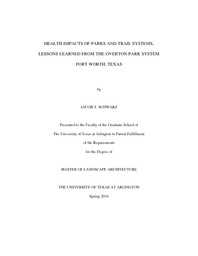
ATTENTION: The works hosted here are being migrated to a new repository that will consolidate resources, improve discoverability, and better show UTA's research impact on the global community. We will update authors as the migration progresses. Please see MavMatrix for more information.
Show simple item record
| dc.contributor.advisor | Ozdil, Taner R. | |
| dc.contributor.advisor | Taylor, Pat D. | |
| dc.creator | Schwarz, Jacob | |
| dc.date.accessioned | 2016-09-28T18:23:56Z | |
| dc.date.available | 2016-09-28T18:23:56Z | |
| dc.date.created | 2016-05 | |
| dc.date.issued | 2016-05-10 | |
| dc.date.submitted | May 2016 | |
| dc.identifier.uri | http://hdl.handle.net/10106/25912 | |
| dc.description.abstract | This thesis explores the health impacts of parks and trail systems on residents by studying the Overton Park System in Fort Worth, Texas. Specifically, this research assesses how park features, amenities, and experiences impact physical activity levels of residents who live nearby. The Overton Park System, as defined in this study, consists of Overton Park, Foster Park, and the trail system that connects them to the Trinity Trail System.
Numerous studies have shown the health benefits of daily physical activity over a sedentary lifestyle (Lewis and Hennekens, 2016). Literature illustrates that parks and trail systems offer an array of amenities and features that encourage physical activity while simultaneously enjoying the outdoors (Gordon et al., 2004). However, the research that explores the impact that parks and trail systems have on physical activity is limited.
This study adopts quantitative research methods as described by (Demming and Swafield, 2011), and collects data through a survey of residents, passive observations, as well as a review of secondary data to assess physical activity levels of residents. A three-part survey focuses on physical activity of residents in four adjacent neighborhoods near the Overton Park System in Fort Worth, Texas. Passive observations and secondary data collection focus on physical attributes and demographic profiles of the park and the neighborhood under question (Lynch and Hack, 1984). Data are analyzed using descriptive statistics and frequencies to report on the impacts that park features, amenities, proximity, accessibility and perception have on resident’s physical activity levels.
This research explores the health impacts parks and trail systems contribute to residents of surrounding neighborhoods and communities. Existing research is used to compare against the data collected in order to find evidence and examples that show people with easy access to parks and trail systems have higher physical activity levels than people who do not have those resources readily accessible (Gordon et al., 2004). The limits of value based on proximity and ease of access to trail systems are explored and established through analysis of data collected through the survey and existing research. Overall, the results generally supported existing literature in that close proximity and ease of access to parks and trail systems is resultant in increased physical activity levels for surrounding residents.
The findings from this study and related studies help reinforce the importance of the profession of landscape architecture and its role in enhancing, respecting, and restoring the life sustaining integrity of the landscape for all living things. Ease of access to parks and trail systems for physical activity should be viewed as having a positive health value, and communities should construct their policies and resources accordingly. Increased public knowledge of the health benefits associated with daily physical activity as related to living in close proximity to parks and trail systems is a benefit to any community. | |
| dc.format.mimetype | application/pdf | |
| dc.language.iso | en_US | |
| dc.subject | Parks and trail systems | |
| dc.subject | Health | |
| dc.title | HEALTH IMPACTS OF PARKS AND TRAIL SYSTEMS, LESSONS LEARNED FROM THE OVERTON PARK SYSTEM FORT WORTH, TEXAS | |
| dc.type | Thesis | |
| dc.degree.department | Landscape Architecture | |
| dc.degree.name | Master of Landscape Architecture | |
| dc.date.updated | 2016-09-28T18:24:59Z | |
| thesis.degree.department | Landscape Architecture | |
| thesis.degree.grantor | The University of Texas at Arlington | |
| thesis.degree.level | Masters | |
| thesis.degree.name | Master of Landscape Architecture | |
| dc.type.material | text | |
Files in this item
- Name:
- SCHWARZ-THESIS-2016.pdf
- Size:
- 4.397Mb
- Format:
- PDF
This item appears in the following Collection(s)
Show simple item record


